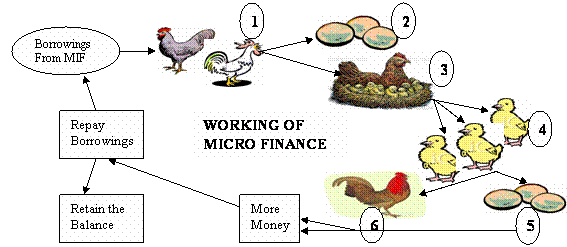Micro Finance
[Submitted by Ms. Swaroopa Bhimathati,
CA (Final),
Nellore, Andhra Pradesh]
September 10, 2008
There are more than 70 million households in India earning less than $1 per day. To make a living, they need as much as Rs.1 lakh crore in credit but at the same time have no access to banks or formal financial services. Therefore, there's a yawing gap between demand and supply thus bringing into the picture the concepts Micro credit and Micro finance.
What is micro finance?
Micro Finance refers to provision of financial services and to poor or low income clients, including consumers and the self-employed in rural, semi-urban and urban areas for enabling them to raise their income levels and improve their living standards. The loans and credit extended are typically small ("micro"). An equally important part of microfinance is the recycling of funds. As loans are repaid, usually in six months to a year, they are re-loaned. This continual reinvestment multiplies the impact of each dollar loaned.
What is micro credit?
It refers to extension of small loans to entrepreneurs too poor to qualify for traditional bank loans.
What is the difference between micro finance and micro credit?
Micro finance is a broader concept when compared with micro credit and the former includes the latter. Micro finance refers to loans, savings, insurance transfer services and other financial services targeted at low-income clients. Micro credit refers to a small loan to a client made by a bank or other institutions, offered often without collateral security to an individual or through group lending.
Who are micro finance clients?
Who ever is unserved and underserved by banks and other formal financial institutions can really become microfinance client. Microfinance clients are typically self-employed, often household-based entrepreneurs.
In rural areas, they are usually small farmers and others who are engaged in small income-generating activities such as food processing and petty trade. In urban areas, microfinance activities are more diverse and include shopkeepers, service providers, artisans, street vendors etc. microfinance clients are poor and vulnerable non-poor who have a relatively stable source of income.
Interestingly, the vast majority of the loans go to women because studies have shown that women are more likely to reinvest their earnings in the business and in their families. As families cross the poverty line and micro-businesses expand, their communities benefit, jobs are created, knowledge is shared, civic participation increases, and women are recognized as valuable members of their families and communities.
What is Microfinance Institution (MFI)?
It comprise a combination of NGOs, NBFCs, Companies constituted U/s 25 of Companies Act,1956 and co-operatives which draw their capital mostly from private banks, SIDBI and foreign investors. MFIs not only provide financial services but also business advices and counseling to its clients.
How does Microfinance work?
It consists of making small loans, usually less than $200, to individuals, usually women, to establish or expand a small, self-sustaining business. This is explained with the below example:
- a women may borrow $50 to buy chickens
- so that she can sell eggs
- and some she can stock for hatching
- as the chickens multiply
- she will have more eggs to sell
- and also she can sell the chicks and can get more money.
With the amount from the sale of eggs and chicks she pays off her loan from MIF and the balance she retains for further expansion. Thus each expansion pulls her further from the devastation of poverty.

How does microfinance help the poor?
- It can help the poor to increase income build viable businesses and reduce their vulnerability to external shocks (illness of wage earner, weather, theft etc).
- It can be a powerful tool for self-empowerment by enabling the poor, especially women to become economic agents of change
- It can play an important role in the fight against many aspects of poverty by providing access to financial services. For e.g., income generation from a business helps not only the business activity expand but also contributes to household income and its attendant benefits on food security, children's education etc. Moreover, for women, who in many contexts are secluded from public space, transacting with formal institutions can also build confidence and empowerment.

